实验1:SDN拓扑实践
实验1:SDN拓扑实践
一、实验目的
- 能够使用源码安装Mininet;
- 能够使用Mininet的可视化工具生成拓扑;
- 能够使用Mininet的命令行生成特定拓扑;
- 能够使用Mininet交互界面管理SDN拓扑;
- 能够使用Python脚本构建SDN拓扑。
二、实验环境
Ubuntu 20.04 Desktop amd64
三、实验要求
(一)基本要求
1.使用Mininet可视化工具,生成下图所示的拓扑,并保存拓扑文件名为学号.py。
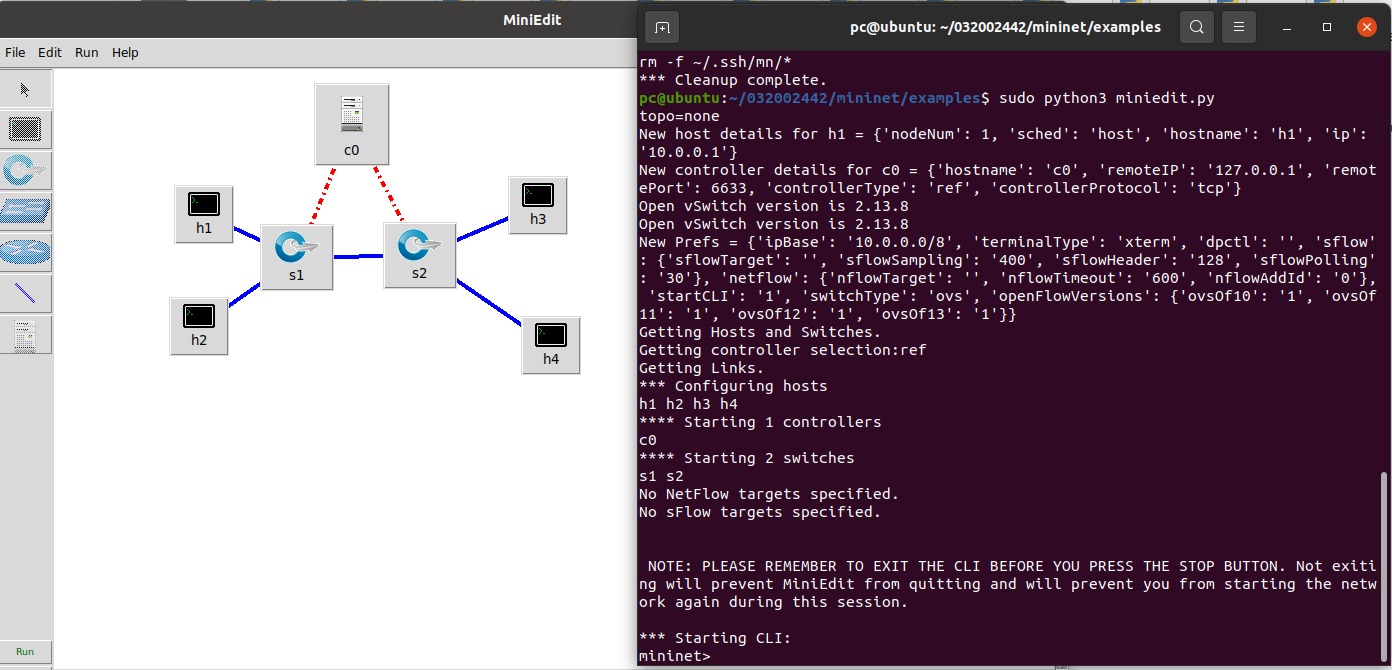
2.使用Mininet的命令行生成如下拓扑:
a) 3台交换机,每个交换机连接1台主机,3台交换机连接成一条线。
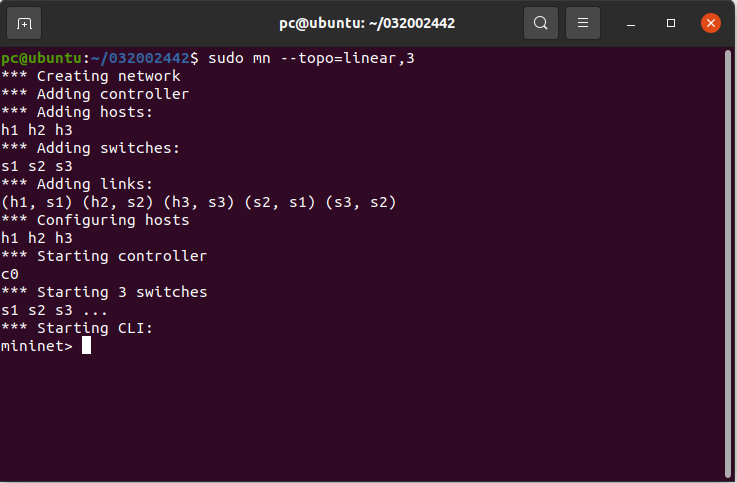
b) 3台主机,每个主机都连接到同1台交换机上。
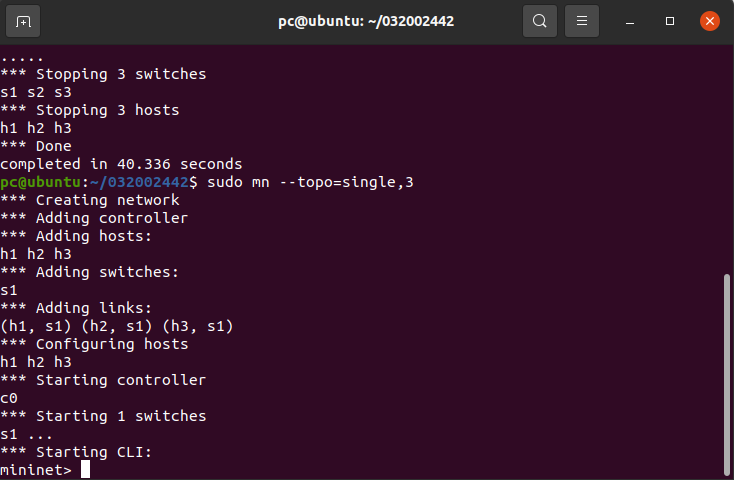
3.在2 b)的基础上,在Mininet交互界面上新增1台主机并且连接到交换机上,再测试新拓扑的连通性。
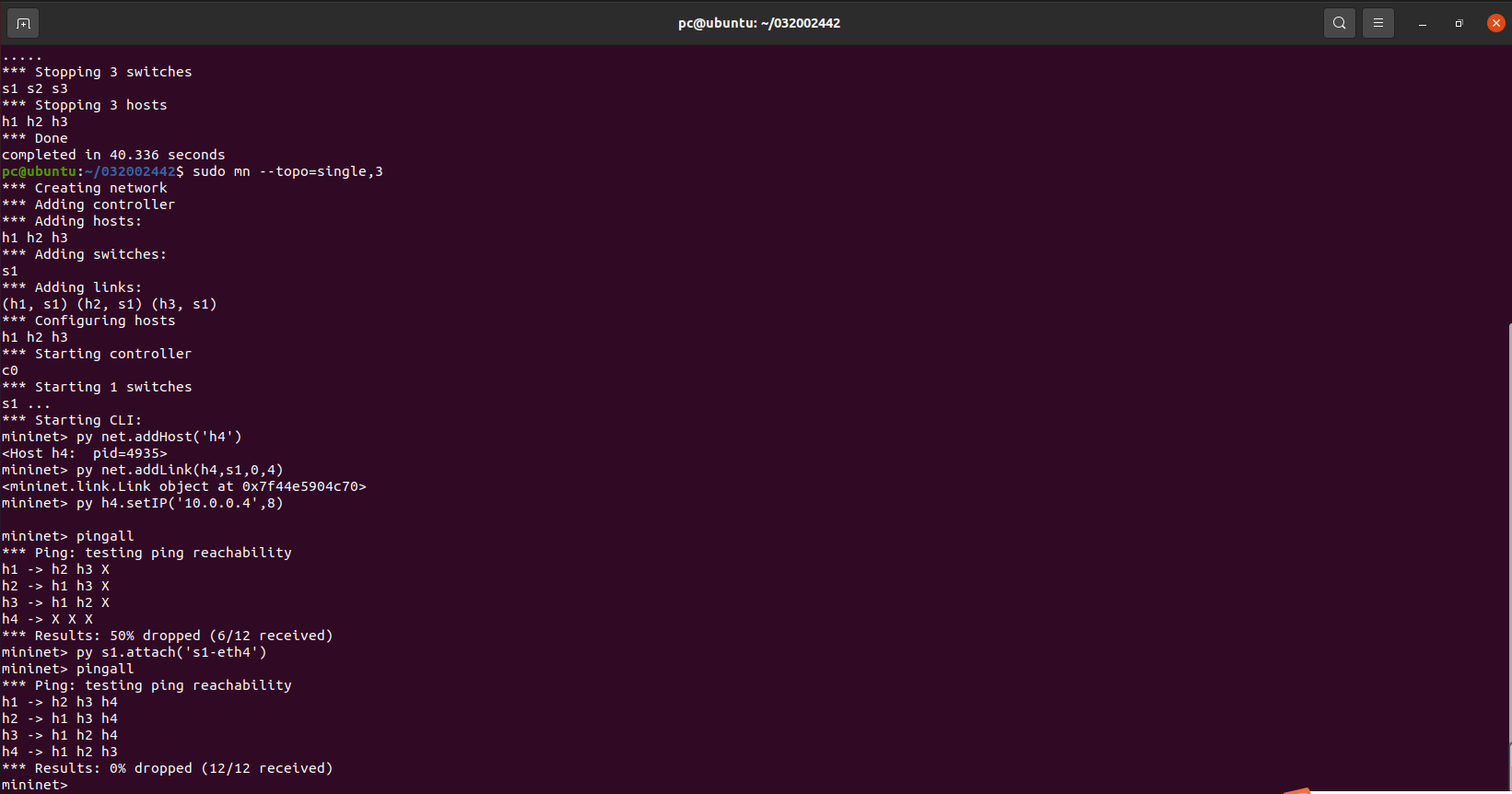
4.编辑(一)中第1步保存的Python脚本,添加如下网络性能限制,生成拓扑:
a) h1的cpu最高不超过50%;
b) h1和s1之间的链路带宽为10,延迟为5ms,最大队列大小为1000,损耗率50。
032002442.py(修改后)
#!/usr/bin/python
#创建网络拓扑
"""Custom topology example
Adding the 'topos' dict with a key/value pair to generate our newly defined
topology enables one to pass in '--topo=mytopo' from the command line.
"""
from mininet.topo import Topo
from mininet.net import Mininet
from mininet.node import RemoteController,CPULimitedHost
from mininet.link import TCLink
from mininet.util import dumpNodeConnections
class MyTopo( Topo ):
"Simple topology example."
def __init__( self ):
"Create custom topo."
# Initialize topology
Topo.__init__( self )
L1 = 2
L2 = L1 * 2
L3 = L2 * 2
first = []
second = []
third = []
# add core ovs
for i in range( L1 ):
sw = self.addSwitch( 's{}'.format( i + 1 ) )
first.append( sw )
# add aggregation ovs
for i in range( L2 ):
sw = self.addSwitch( 's{}'.format( L1 + i + 1 ) )
second.append( sw )
# add edge ovs
for i in range( L3 ):
sw = self.addSwitch( 's{}'.format( L1 + L2 + i + 1 ) )
third.append( sw )
# add links between core and aggregation ovs
for i in range( L1 ):
sw1 = first[i]
for sw2 in second:
# self.addLink(sw2, sw1, bw=10, delay='5ms', loss=10, max_queue_size=1000, use_htb=True)
self.addLink( sw1, sw2 )
# add links between aggregation and edge ovs
for i in range( L2 ):
t=i
sw1=second[i]
if (i%2)!=0:
t=t-1
t=t*2
for sw2 in third[t:t+4]:
self.addLink( sw1, sw2 )
#add hosts and its links with edge ovs
count = 1
for sw1 in third:
for i in range(2):
host = self.addHost( 'h{}'.format( count ) )
self.addLink( sw1, host )
count += 1
topos = { 'mytopo': ( lambda: MyTopo() ) }
执行结果截图
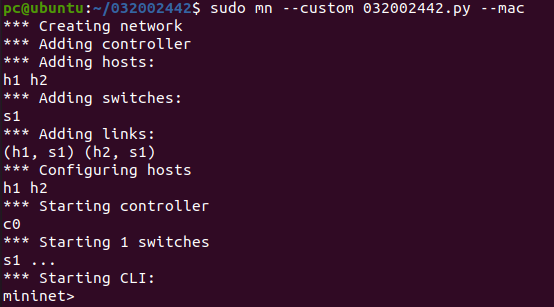
(二)进阶要求
032002442_fattree.py
#!/usr/bin/python
#创建网络拓扑
"""Custom topology example
Adding the 'topos' dict with a key/value pair to generate our newly defined
topology enables one to pass in '--topo=mytopo' from the command line.
"""
from mininet.topo import Topo
from mininet.net import Mininet
from mininet.node import RemoteController,CPULimitedHost
from mininet.link import TCLink
from mininet.util import dumpNodeConnections
class MyTopo( Topo ):
"Simple topology example."
def __init__( self ):
"Create custom topo."
# Initialize topology
Topo.__init__( self )
L1 = 2
L2 = L1 * 2
L3 = L2 * 2
first = []
second = []
third = []
# add core ovs
for i in range( L1 ):
sw = self.addSwitch( 's{}'.format( i + 1 ) )
first.append( sw )
# add aggregation ovs
for i in range( L2 ):
sw = self.addSwitch( 's{}'.format( L1 + i + 1 ) )
second.append( sw )
# add edge ovs
for i in range( L3 ):
sw = self.addSwitch( 's{}'.format( L1 + L2 + i + 1 ) )
third.append( sw )
# add links between core and aggregation ovs
for i in range( L1 ):
sw1 = first[i]
for sw2 in second:
# self.addLink(sw2, sw1, bw=10, delay='5ms', loss=10, max_queue_size=1000, use_htb=True)
self.addLink( sw1, sw2 )
# add links between aggregation and edge ovs
for i in range( L2 ):
t=i
sw1=second[i]
if (i%2)!=0:
t=t-1
t=t*2
for sw2 in third[t:t+4]:
self.addLink( sw1, sw2 )
#add hosts and its links with edge ovs
count = 1
for sw1 in third:
for i in range(2):
host = self.addHost( 'h{}'.format( count ) )
self.addLink( sw1, host )
count += 1
topos = { 'mytopo': ( lambda: MyTopo() ) }
执行结果截图

个人总结
这次实验的进行过程比较顺利,没有遇到什么太大的问题,之前在51openlab做过相关实验。实验本身难度较低,但是要熟练掌握mininet的相关操作还是需要一定的时间。由于对python的语法不是特别了解,接触的都是用python写控制器的代码,在写进阶要求的代码时较为吃力,未来有机会要过一遍python的基本语法。
本次实验遇到的部分问题记录如下:
① 在运行mininet/examples/miniedit.py时遇到以下问题

经查阅python的版本为2.7.18,与mininet的不相容

本来先卸载了2.7.18,装上python3,但有更好的方法,进入相关目录后
sudo python3 miniedit.py指定运用python3运行
② 当多次在miniedit构建相同的拓扑时,出现以下错误

运用sudo mn -c清理






 浙公网安备 33010602011771号
浙公网安备 33010602011771号